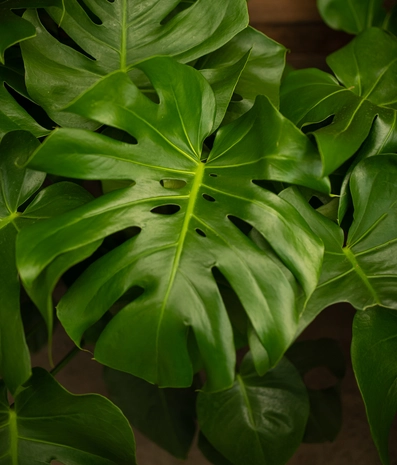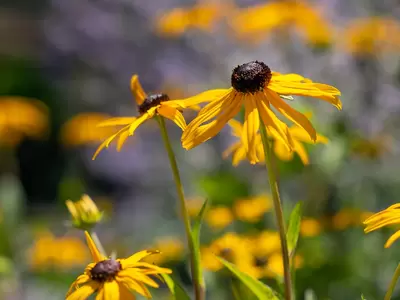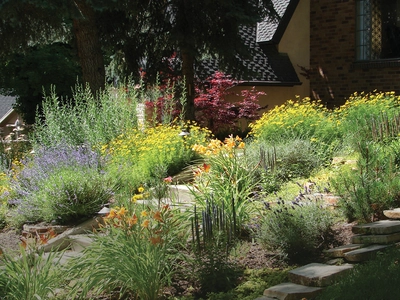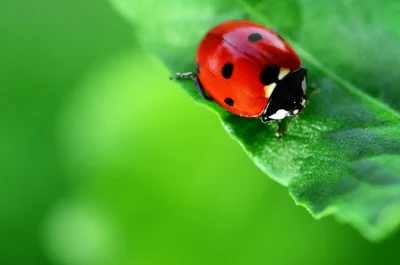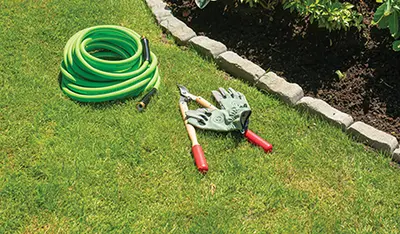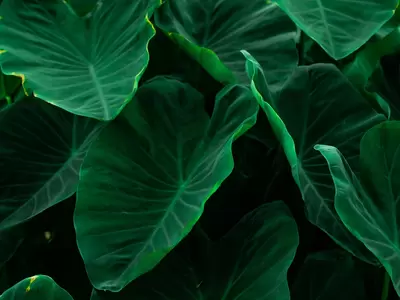
Written by Ingrid Hoff
Good news, the borders will soon be reopening and we will be free to move about the Earth once again… that is if you want to. I know more than a few people who are planning to stay close to home, but then I also know some who are already buying plane tickets. Everyone’s got their own level of comfort with the “great opening up,” but I think we can all agree that things have changed. We now know the importance of creating a space all of our own, right at home. So, it got me to thinking of the idea of adding a bit of tropical flair to our own outdoor spaces. You don’t actually need to go south of the border to get tropical.
It can be as easy as choosing the right plants. You want to go big… big flowers, big colours but mostly big leaves. A lush tropical space is built around the strategic use of foliage. Shiny leaves, big round leaves, spikes leaves, and even lacy leaves (think giant ferns) can give you that jungle-like feel. More is better in a tropical garden, especially when it comes to flowers. Forget about monochrome white themes, you need lots of hot colours. And consider using contrasting colours, go bold with reds, oranges, pink and corals. Annuals can be a great source of hot tropical colours to fill in garden gaps, and you can feel free to experiment and take more colour risks with annuals, since there is less commitment.
Which brings me to the idea of having a “piece of the tropics” on your patio or balcony with container plantings. Not only for annuals, growing some of the more tender tropical plants in a container is a great idea since it’s much easier to move them to sheltered protected spots for the winter months. So, your patio or balcony can easily become a tropical retreat.
The following are my picks for giving your garden a tropical flair.
Hardy Banana (Musa basjoo) did you know there is such a thing as a hardy banana? And really what could be more tropical than a banana. Originally hailing from southern China, it has the most amazing large lush green leaves. Hardy to Zone 5, just mulch well to protect the roots, and give it some extra care for the first few years as it gets established. The leaves die back in the winter, but don’t worry, new ones will unfurl in the spring. The biggest challenge with overwintering bananas is how wet our winters are, most will rot before they freeze. Make sure to give it full sun or partial shade, moist but well-draining soil. A question I often get is “will it produce fruit?” The answer is not usually, but it’s possible if it’s mature enough and the temperature is hot enough, apparently, they are small but tasty.
Red Banana (Ensete ventricosum ‘Maurelii’) is a beautiful semi-hardy banana with green and burgundy-red variegated foliage and stems. Hardy to Zone 9 it will need a bit more protection in the winter and is a perfect candidate for container growing. Otherwise treat it in a similar manner to hardy banana.
Windmill palm (Trachycarpus fortunei) is a palm tree from Asia that is hardy to
Zone 7 so completely “doable” on the mild coast. An actual palm tree in your space is instantly going to give you a tropical vibe. Growing anywhere from 12-20m (39-66’) tall it can become a formidable tree, so make sure to give it a bit of room. The large, fan-shaped palm leaves emerging from a sturdy central trunk that is covered in brown fibrous hairs. Make sure to plant it in full sun to partial shade, and sheltered from strong winds. Give it some protection from extreme cold in the first few years as it’s getting established.
Cordyline australis (cabbage tree) is not quite a palm tree but the spiked leaves of this single stemmed plant make it look like one. An extremely easy plant to grow, it might need some protection in cold weather (it’s considered hardy to Zone 9 but personally I’ve seen it covered in snow and recover just fine). Plant it in full sun to part shade. Two cultivars to look out for are ‘Red Star’ which is a chocolatey merlot colour, and ‘Torbay Dazzler’ for its bright yellow and green striped variegation.
Elephant ear (Colocasia sp. and Alocasia sp.) are often confused and interchanged since they both boast bold beautiful big heart shaped leaves. Both make great additions to the tropical garden and just in case you are curious colocasia leaf tips point down, and with alocasia the leaf tip points up. Semi-hardy (Zone 9) they grow from a bulb and need good moisture (never let them dry out), in fact they make great pond plants growing with the pot submerged. Part sun is preferred as the big leaves can burn in hot direct sun. If you are concerned about overwintering them, then dig up the bulbs and store them for the winter.
Canna lilies have it all, large colourful bold leaves and large colourful bold flowers. Their giant paddle-shaped leaves come in a range of colours from vibrant green, bright orange/red, and even striped. Plant them in moist well-drained soil, with sun to part shade. These are great plants for containers. Hardy to Zone 7 they should be mulched well or planted in containers and moved to a sheltered site for the winter. ‘Tropicana’ is a popular cultivar with colourful striped leaves and vibrant orange blooms.
Shade gardens need some tropical love too, the sunny spots shouldn’t have all the fun. Luckily there are lots of options for large leaved and lacy textured plants that thrive in the shade. Consider using large leaf hostas, ferns, ligularia, and even large white calla lilies (Zantedeschia aethiopica). A shady spot can be the perfect retreat from the sun while still giving you those jungle vibes.
Creating your own staycation oasis is within everyone’s reach. And even if you do plan on digging out the passport you can still turn your garden/patio into a tropical oasis, just think it will give you a season of rest and relaxation instead of a week or two. Just choose your plants accordingly and don’t forget to put a mini-umbrella in your drink. The best part… no jet lag involved.

